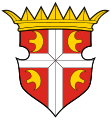Tetragram cross
The tetragram cross or beta cross is a Greek bar cross , each of which has a fire steel or beta in its four quadrants .
It is a Christian symbol and, along with the double-headed eagle, was the emblem of the emperors of the Byzantine Empire .
Currently it appears as a heraldic coat of arms figure in the coat of arms of Serbia , in which it was adopted by Serbian rulers of Byzantium in the Middle Ages . Through the connection as a common figure of the Serbian coat of arms, it has also become a national symbol (so-called "Serbian cross").
history
Antiquity
Motifs with the tetragram cross can already be found in ancient times on representations or works by the Greeks .
middle Ages

The tetragrammatic cross appears on Byzantine coins from the reign of Emperor Theodor II (1254–1258) . In contrast, no Byzantine coin with the double-headed eagle has been found to date. The tram cross is also depicted on the walls of the Porphyrogennetos Palace in Constantinople as well as on cards and banners .
The Byzantine author Pseudo-Kodinos describes the tetragrammatic cross in his work De officiis, which was created around 1347 to 1368, as "the usual imperial banner [ flamoulon ], ie the cross with a firing bolt". It is therefore likely that the images in the angles of the tetragram cross are symbols or fire steels . The angle symbols could also stand for the second letter of the Greek alphabet Beta and thus for the variations of the word basileus . As a tetragram thus for the Greek designation of the name of God Basileus Basileon Basileuon Basileuonton (Βασιλεύς Βασιλέων Βασιλεύων Βασιλευόντων) for "King of kings, rules over the rulers".

In Byzantium, the heraldry , which emerged in the west from the 12th century , was not known in this sense. In the western world, however, the tetragram cross was given heraldic value. Late 13th century the Tetragrammaton cross appears as a coat of arms figure in about 1265 to 1270 resulting Armorial Wijnbergen the Byzantine emperor of the dynasty of the emblem Palaiologoi ( " roi de pariologre ") in gold on a red field .
The tetragram cross was also adopted by Byzantine vassals . It was used as such by the Genoese Gattilusi family , who ruled Lesbos after 1355 . Serbian rulers also adopted the Byzantine tetragram cross in their coat of arms.
The Marquis of Monferrato used the Tetragrammaton Cross in her arms rulers to their family connection to the Byzantine Palaiologoi pointed dynasty. Likewise, the Italian noble family Gonzaga .
Historical use (selection)
Banner of the Byzantine emperors
Coat of arms of the "Emperor of Constantinople " (heraldic manuscript , England , 15th century )
Coat of arms of Wilhelm XI. as Margrave of Montferrat (1494–1518)
Coat of arms of the Italian noble family Gonzaga (1575)
literature
- Robert Ousterhout: Symbols of Power: Medieval Heraldry between East and West . In: Margit Mersch, Ulrike Ritzerfeld (eds.): Latin-Greek-Arabic encounters: Cultural diversity in the Mediterranean region of the late Middle Ages (= Europe in the Middle Ages . Volume 15 ). Akademie Verlag, Berlin 2009, ISBN 978-3-05-004664-8 , pp. 91-110 .
- Andrea Babuin: Standards and insignia of Byzantium . In: Byzantion. Revue internationale des études byzantines . tape 71 , 2001, ISSN 0378-2506 , p. 5–59, here pp. 36–38 .
- Aleksandar V. Solovjev: Les emblemes heraldiques de Byzance et les slaves . In: Seminarium Kondakovianum . No. 7 , 1935, ZDB -ID 401738-9 , p. 119-164 .
Web links
- heraldica.org: Heraldy in Byzantinum? Retrieved December 22, 2015 .
Individual evidence
- ^ Günther Schuhmann: The "Empress of Constantinople" in Nuremberg. On the stay of the paleologist Zoe on her journey from Rome to Moscow in 1472. In: Horst Heldmann (Ed.): Archives and historical research. Studies on Franconian and Bavarian history. Fridolin Solleder for his 80th birthday. Schmidt, Neustadt (Aisch) 1966, pp. 148-174, here p. 166, footnote.
- ↑ Robert Ousterhout: Symbols of Power. Medieval heraldry between East and West. In: Margit Mersch, Ulrike Ritzerfeld (ed.): Latin-Greek-Arabic encounters. Cultural diversity in the Mediterranean region of the late Middle Ages (= Europe in the Middle Ages. 15). Akademie Verlag, Berlin 2009, ISBN 978-3-05-004664-8 , pp. 91–110.
- ^ Leopold Auburger : The Croatian Language and Serbo-Croatism (= Heilighofer Studies . Volume 7 ). Gerhard Hess, Ulm 1999, ISBN 3-87336-009-8 , p. 418 : "The 'ocilo' [fire steel] is an ethnic symbol only as an element of a multi-part symbol: in the Serbian national coat of arms in connection with the heraldic cross ..."
- ↑ Alexander Van Millingen: Byzantine Constantinople. The Walls of the City and Adjoining Historical Sites . John Murray, London 1899, p. 112 ( archive.org - illustration).
- ↑ Pseudo-Kodinos: De officiis . = Traité des offices. Introduction, texte et traduction by Jean Verpeaux. Ed .: Cente National de la Recherche Scientifique (= Les monde byzantin . Volume 1 ). 1966, ISSN 0544-7704 , p. 167 , lines 17-23 .
- ↑ Dan Cernovodeanu: Contributions à l'étude de l'héraldique Byzantine et postbyzantine . In: Yearbook of Austrian Byzantine Studies . tape 32 , no. 2 , 1982, p. 409-422, esp. 415 .
- ↑ Aleksandar V. Solovjev: Les emblemes héraldiques de Byzance et les slaves . In: Seminarium Kondakovianum . No. 7 , 1935, pp. 119-164, here pp. 161-162 .
- ↑ Aleksandar V. Solovjev: Les emblemes héraldiques de Byzance et les slaves. In: Seminarium Kondakovianum. No. 7, 1935, pp. 119-164, here p. 159 f.









